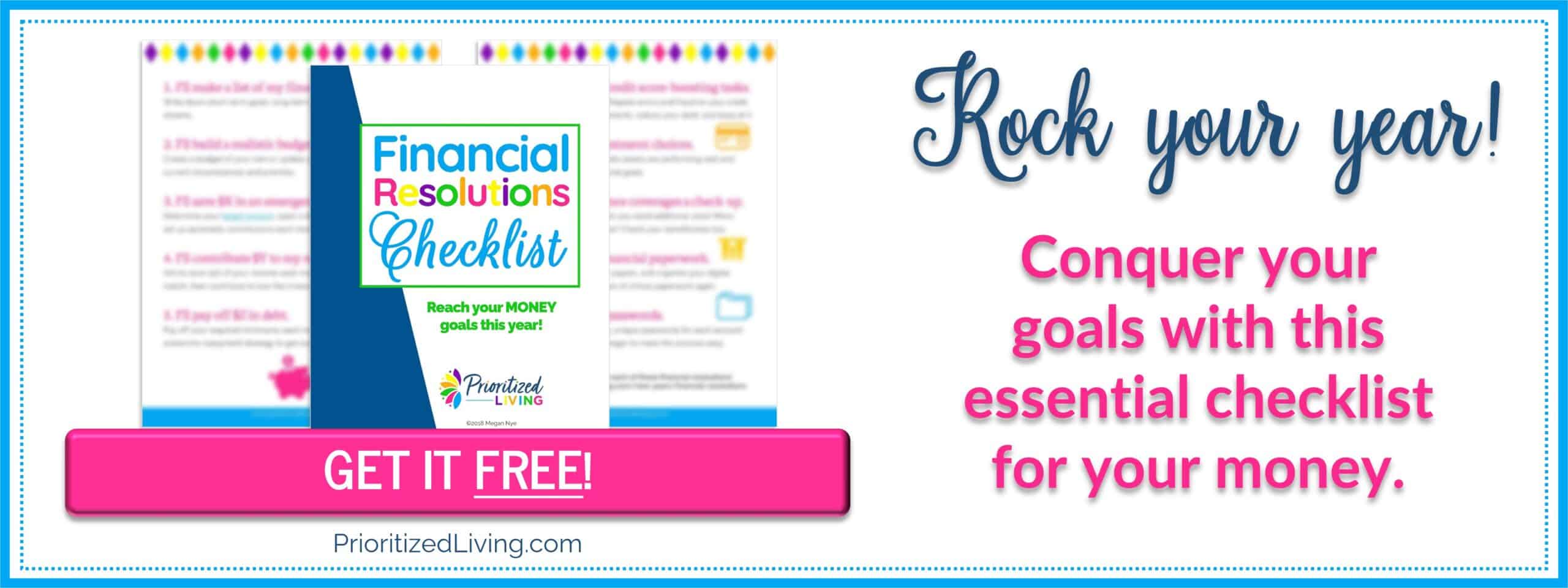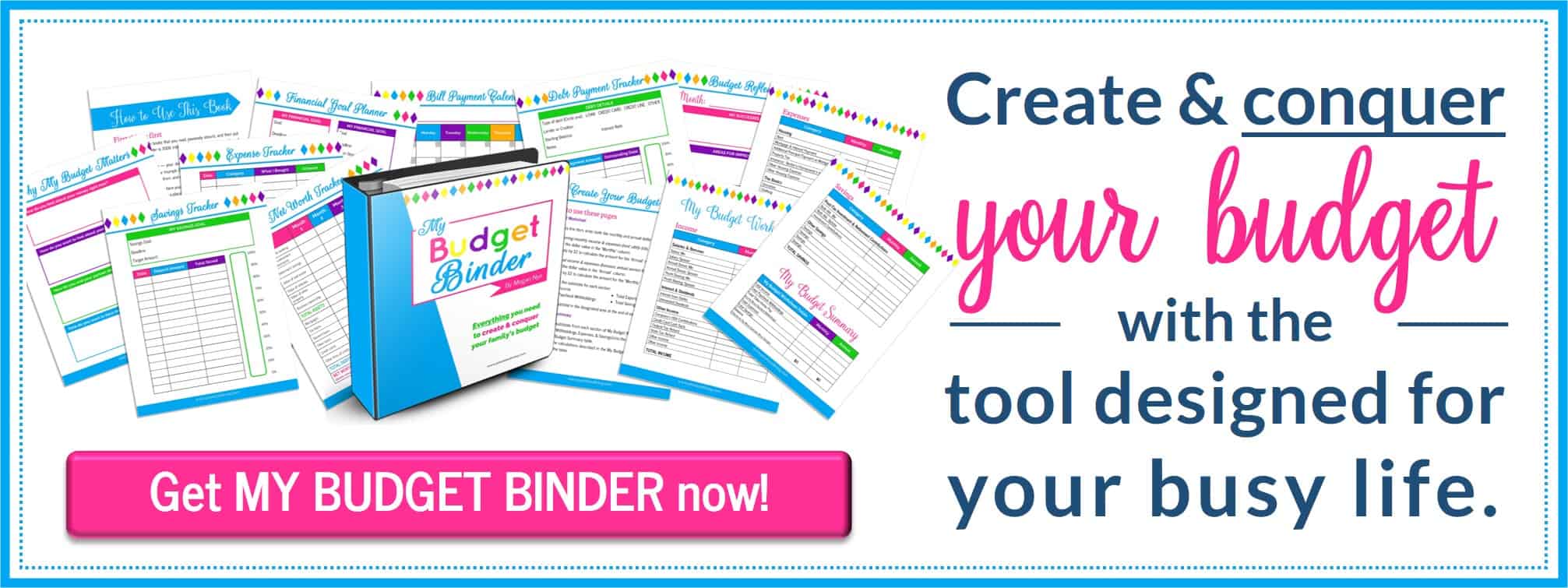Your year is powerful.
I firmly believe that — with the right tools, motivation, and action plan — a person can accomplish amazing things in a single year.
And that feeling you get when starting out? When you embark on a new journey with resolve and enthusiasm, you know you have the chance to make real, positive changes that can last a lifetime.
In a single year, you can master and transform your money.
No matter where you are on your journey to financial health and security. No matter what setbacks you’ve had. No matter what obstacles lie ahead.
You can improve your finances, making incredible strides in a single year.
These 11 steps offer a path to establishing strength and security with your family’s finances. Maybe you’ve already tackled some of them! Or maybe you’re just starting out.
Either way, jump in and make this the year that you create peace of mind and financial health for yourself and your loved ones.
1. Identify your motivation.
When it comes to big goals, it’s highly likely you’ll veer off course if you can’t peg the purpose behind your goal. Why bother engaging in the hard work and occasional sacrifice day in and day out if you can’t pinpoint your “why”?
So, while step 1 might sound like a layover on the way to getting started, it’s essential if you’re going to reach your goals!
You need to get true clarity on your financial goals.
So, when the going gets tough, that big goal prompts you to keep pushing. How do you do it?
Write down your goals and your “why” clearly. (A scientific study found that you’re 50% more likely to achieve your goals when they’re written down!) Maybe you have a single, major motivation pushing you toward your goal, or you’ve got a number of reasons.
Your list might look something like this:
| My financial goal | Why it matters to me |
| Build an emergency fund that covers 12 months of my family’s expenses. |
|
| Create and follow a budget. |
|
| Make time every Thursday night for paying bills. |
|
| Boost my 401(k) contribution enough to get the maximum employer match. |
|
2. Get crystal clear on where you are right now.
In order to get from where you are to where you want to be, you first need to know exactly where you are when it comes to your money.
Fair warning: If you’ve never gone through this process before, it can take some time.
You’ll need to gather and organize your records, so you have all the information you need. The goal here is to paint a complete picture of your current finances.
Despite the time investment upfront, going through this process is 100% worth it!
After all, not knowing where you stand financially is stressful. Understanding your current circumstances — even if you find out they’re not ideal! — can help you make well-informed choices for the present, create goals for the future, and map out your path from here to there.
So gather the following information with specific dollar amounts wherever possible:
- Your assets: savings, investments, property owned, etc.
- Your liabilities: mortgages, car loans, student loans, and other sources of debt
- Your income: your salary, your spouse’s salary, bonuses, commissions, bank interest, credit card cash back, etc.
- Your current expenses: fixed costs (mortgage, auto insurance premium, etc.), variable expenses (groceries, entertainment, etc.)
- Upcoming expenses: a tuition bill that’s due in 6 months, a medical procedure you’re getting next month, etc.
Make it easy! Looking for a comprehensive way to capture where you are so you can improve your finances? Walk through the step-by-step worksheets in My Budget Binder to ensure you’ve got all the information you need!
3. Specify where you want your finances to be in 12 months.
Now that you know where you are, you can start to look to the future.
What about your finances right now makes you happy? What do you plan to keep doing? And what would you like to change? Specifically, how would you like your money to look in one year?
Before you start brainstorming, you’ll want to ensure your goals are actually achievable. And the key to setting realistic financial goals is understanding these two concepts:
TRUTH #1: You can’t do it all at once.

Pick your battles.
Choose the goals you want to tackle first and work on doing those well before you add in more. Spreading yourself too thin can easily stress you out and prevent you from reaching even a few of your goals.
TRUTH #2: Some financial goals take a long time to achieve.
They’re worth doing, but you may not be able to accomplish a major goal in a single year.
For instance, it’ll most likely take decades to save enough to retire and years to increase your credit score a few hundred points.
Focus on what’s achievable.
So maybe you’ll save 15% of your salary (including your company match) toward retirement this year. And you’ll pay off $6000 in debt while paying every bill on time to give your credit score a nice bump up by year’s end.
4. Flesh out your emergency fund.
If your emergency fund isn’t where it should be, getting it there — or moving it closer to that goal — should be one of your top priorities.
Without a good financial cushion in place, you’re rolling the dice with unexpected and unwanted bills. So, if you suddenly need to pay a medical bill or repair your furnace, you may find yourself scrambling for cash.
And that’s when people tend to be forced into debt — high-interest credit cards, even higher-interest payday loans, home equity loans, etc.

So start by identifying how much money you should have saved up for an emergency.
If you’ve already hit your target, congratulations! You’re practically a unicorn in today’s economy.
If you’re not there yet, figure out an achievable goal for this year’s savings.
Remember: Depending on where you are, it may not be realistic to reach your ultimate savings goal for your emergency fund this year. But you can certainly plan to increase your savings by a specific dollar amount this year and keep going next year.
Be sure you’re putting your emergency savings in a savings account — not investments that might decrease in value. And, if possible, dedicate an account specifically to your emergency savings. That way, you’ll always know what cash is for everyday bills and what’s there for true emergencies.
5. Pay down debt strategically.
Some financial “experts” oversimplify the idea of debt — insisting that paying all of it down as soon as possible is the only correct course of action.
And, admittedly — even with a low interest rate — your debt is costing you.
But sometimes that cost is actually a fair exchange: You’ve got a mortgage to pay for a home that you can live in right now. Or you took on a reasonable amount of student loan debt to go to college and got a good-paying job that’ll pay off that debt.
And sometimes paying down your debt faster actually loses you money!
So if you’re enjoying a low, fixed interest rate on your mortgage while earning much higher returns on investments, it makes no sense to sell those money-making assets to pay off inexpensive debt. The cash you earn on your portfolio is covering your mortgage interest and then some!
But there are plenty of times that paying down debt is 100% the right move.
Focus on your “bad debt” — the financing that’s truly costing you money:
- Credit card debt
- Payday loans
- Most personal loans
- Most home equity loans and home equity lines of credit
- Some car loans (which pay for a depreciating asset — your vehicle)

So what can you do this year?
Identify your bad debt. Then look at your budget and see how much additional money you can add to your current payments on those accounts.
If you’re currently paying just the monthly minimum owed, look into increasing your monthly principal payment by $10, $100, or even $500. Again, set achievable goals here.
My favorite method for paying down debt as quickly and inexpensively as possible is the debt avalanche method. (Here’s a great calculator you can use to enter your debt details and get a step-by-step debt payoff plan.)
Of course, as you pay off your debt, make sure you work on good credit habits to ensure you don’t slip back as you move ahead:
- Pay at least your monthly minimums on time every month.
- Keep your credit utilization rate lower than 30% — and lower than 10% if you want the very best score.
- Check your credit reports and credit scores regularly to catch fraud, spot mistakes, and track your progress.
6. Save for future expenses automatically.
I love the power of automation!
When you automate your savings, you take away the requirement — and the pressure! — of being perfectly organized when it comes to your finances. Of remembering, scheduling, and juggling all of your financial transactions on time every time. And of spending hours to do it all.
Instead, put your saving on autopilot.
Take a look at your budget. What are the savings goals you’ve spelled out there? Maybe some of these:
- Retirement,
- Your kids’ educational expenses,
- A family vacation,
- Christmas gifts,
- A down payment for a house,
- . . . or something else!
Many banks let you easily create several savings accounts. So you can create one for each savings goal you have and establish sinking funds in a snap.

From there, do a one-time setup of recurring automatic transfers into those accounts. Many people do monthly transfers, but you can also arrange for money to be moved from your everyday account to your sinking funds whenever you get paid.
Contributing to an investment account?
Most banks and brokerage firms allow you to link your investment account to your checking account. So you can set up recurring transfers for your investments and retirement savings as well.
Then — with just a few clicks — you can ensure your saving plan is on autopilot so you reach your goal on time without any additional work on your part!
7. Save seriously for retirement.
Speaking of retirement accounts, are you contributing enough to yours? Experts recommend that you sock away a solid 15% of your income in order to set yourself up securely for retirement.
For many people, that target’s a big stretch from where they are now or what they believe they can reasonably save. So — if you’re not yet saving for retirement or are setting aside only a few hundred dollars a year — that 15% figure might come as a major shock.
But you can absolutely take steps this year to analyze your budget and see where you can make room to contribute even more to your retirement accounts.

So, suppose your company matches up to 6% of your pay in matching contributions to your 401(k) or Roth 401(k). You can set up that 6% contribution from your paychecks, cash in on your employer’s matching 6%, and contribute an additional 3% to your own Roth IRA. And that gets you to 15% annual retirement savings.
If you’re just getting started with investing, I recommend you do a bit of reading so you feel comfortable creating a plan to save. Read reputable online articles, or check out trusted personal finance books from your local library. You’ll want to explore the ins and outs of Roth IRAs, traditional IRAs, 401(k)s, 403(b)s, and other types of retirement accounts.
8. Invest wisely.
The individual assets you choose for your portfolio depend entirely on what your goals are. So if you’re funding an investment account that’s intended to pay you dividends, your portfolio’s makeup could look quite different than a retirement account you won’t be tapping for decades.
So be clear about the goals you have for each type of investment account or plan you have, like the following:
- Brokerage accounts (non-retirement investment accounts)
- 401(k) plans and Roth 401(k) plans through your employer
- Traditional IRAs and Roth IRAs you set up yourself
- Health Savings Accounts (HSAs)
- College savings accounts (529 plan, Coverdell ESA, etc.)
Review your risk profile, so you feel comfortable with the asset allocation you have for each type of account (large-cap stocks, bonds, international, stock, etc.). Adjust your selected investment as needed.
When choosing individual stocks, bonds, index funds, etc., be sure to look not only at its reputation and past performance but at the cost of owning each asset. Fees can have a shockingly large impact on your savings over time!
In my own portfolio, I love owning commission-free, exchange-traded funds (ETFs), which have very low expense ratios and no cost at all for trading.
Don’t forget! World events and market fluctuations can cause significant changes — good or bad — to any investment portfolio over time. So it pays to give your investments themselves and your investment strategy a good look every year.
Toward that end, you’ll also want to ensure your portfolio maintains your desired asset ratio. So rebalance your portfolio to match your desired level of risk periodically, or set up your account or a robo-advisor to handle that for you.
9. Review your insurance coverages.
It’s always a smart idea to do an annual review of your insurance policies.
Life continually brings new circumstances — a new baby, a kid off to college, a scheduled medical procedure, and more. And then there’s the impact of new legislation or changes in your policy’s fine print.

Health & Dental Insurance
Federal and state regulations for health insurance change often, so do a quick search to see what’s changing this year that may impact your family.
Then take a look at your existing coverage alongside the insurance needs you anticipate you’ll have this year. Is your policy still the best fit for you, or would another option available provide better coverage or higher savings?
Home & Auto Insurance
Two of the most valuable assets you likely own are your home and your car. So protecting yourself financially in those areas can keep your money secure and bring you incredible peace of mind.
Make sure your policies offer high enough limits and low enough deductibles that you wouldn’t be in a tough spot financially if disaster did strike. You don’t want to be worrying about money if you’re in a car accident or facing a major home repair.
Take advantage of the opportunities your insurer offers to save money on your home or car insurance.
And don’t forget: If you rent, you still need to protect yourself and your belongings! Look for comprehensive but well-priced renter’s insurance. You can often get a sizeable discount by bundling your home or renter’s insurance with your auto policy.
Life Insurance
Do you need life insurance? What kind do you need? And how much should coverage should you have in place?

And you’ll typically want to choose term insurance over universal or whole life policies. Term insurance is the cheapest option, and it ensures that you pay for it only as long as people depend on your financial contribution. So, when the kids are gone or your spouse has enough in retirement to live out his life in a financially comfortable fashion, you might opt to ditch the coverage.
For more details on how to choose a life insurance policy, check out this comprehensive post!
(And read up on some common life insurance mistakes people make!)
Disability Insurance
Plenty of people think about how their families will fare financially if they die, but a lot of us don’t consider the impact a disability would have.
After all, life insurance pays out if you’re gone, but what happens if you’re injured and unable to work? It could be just a couple of months or possibly a long-term illness. Either way, that means less income for you and probably higher expenses and medical bills.
That’s where disability insurance comes in.
Many employers do offer group disability coverage for their employees — often at no cost to you. But it’s important that you check your coverage, even if you have insurance through your job.
The disability insurance you receive through your employer is likely insufficient.
Plenty of policies require a long lead time before you can start collecting benefits. Or they pay out only 60% of your income. Thinking about a potential long-term disability in your life, do you feel comfortable living on just 60% of your income for decades?
Track down the plan details for any short-term disability and long-term disability coverage you have. Look specifically for information on the elimination period (how long you have to wait to receive payments), the duration of the payments, and the amount you can expect to receive.
Plus, check out whether your coverage is for “own occupation” or “any occupation.” (You want a policy that will protect you if you can’t do your job — not refuse to pay out if you can still do some job.)
If you feel your short-term or long-term policy is insufficient in some way, explore your options for supplemental coverage. It’s easy to get a quote and get a supplemental disability policy online, and some even offer the option for no medical exam.
10. Look into ways to pay for the big stuff without paying taxes.
While you’re thinking about insurance and investments, it’s a great time to explore the ways you use tax-sheltered savings to cover special expenses.
Healthcare
Look into a Health Savings Account (HSA) or Flexible Spending Account (FSA). With both, you can save tax-free dollars to use on eligible medical expenses.
And, if you qualify for an HSA, you can choose to invest your savings so they grow along with the market. Use them for medical expenses now, or save some to cover healthcare costs decades down the road.
Childcare & Eldercare
If you’ve got at least one kid, you know the high cost of childcare!

That includes day care, after-school programs, day camps, nannies, and more.
And, if you’re responsible for a dependent adult, you can use tax-free funds for that as well. So your DCFSA can pay for adult day care, senior care, at-home care, and more.
It all amounts to a nice tax deduction that helps you pay for some of those high costs.
Educational Savings
Looking to save for your child’s education or even your own?
Take advantage of tax-advantaged savings funds like a 529 Plan and Coverdell Education Savings Account (ESA). Depending on the type of account you choose and the state in which you live, you could grab a tax deduction on the contributions you make, the earnings on your investments, or the amount you withdraw for qualified educational expenses.
And don’t think that we’re talking just about college here! Recent legislation now allows you to use 529 Plan money for some K – 12 costs as well.
Want to know more about your educational savings options? Check out this article I ghostwrote for Finivi.
11. Be generous.
No matter what your financial situation may be, the sad fact is this:
There’s always someone worse off than you.

But, when life turns around — when you’re in a position to do something, to give something to another human, you have the opportunity to enrich the world.
So it makes sense every year to see if you’re able to contribute financially to bettering society. Yes, money isn’t everything, but it does go a long way to improving many societal problems.
Consider the causes that matter most to you, thoroughly research a relevant charity, and give as generously as you can.
What now?
Tackling all 11 of these tasks can certainly be a monumental undertaking. And it may take more than a year for you and your family.
But in this year, you can most certainly begin to build a brighter, more secure financial future for yourself. And you can take steps to master your money and feel confident in your financial strength.
Which step are you committed to tackling this year? What’s your motivation? And what are the challenges you foresee?












Leave a Reply